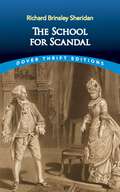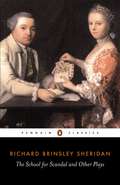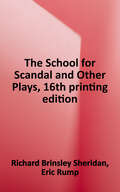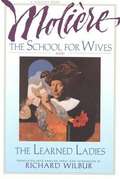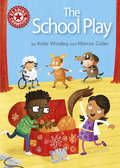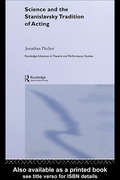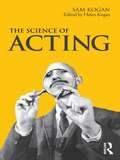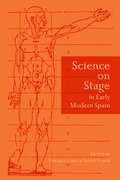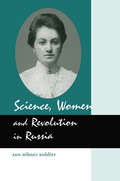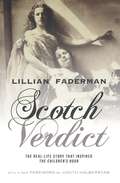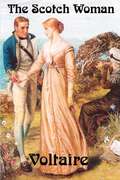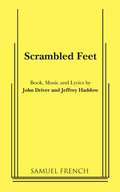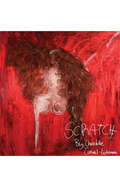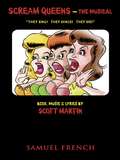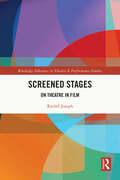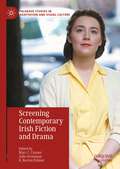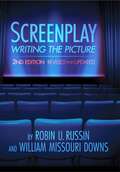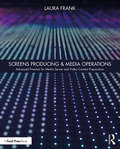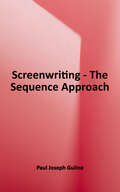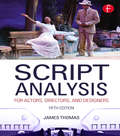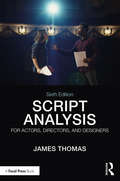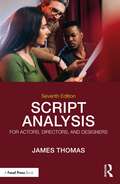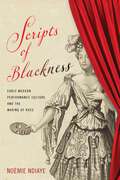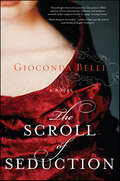- Table View
- List View
The School for Scandal: A Comedy... (Dover Thrift Editions)
by Richard Brinsley SheridanThe intrigues of such aptly named characters as Lady Sneerwell, Sir Joseph Surface, Lady Candour, and Sir Benjamin Backbite have amused theater audiences for more than two centuries. They are the invention of the Irish-born playwright Richard Brinsley Sheridan, and they unfold, collide, and backfire hilariously in his masterpiece, The School for Scandal, a play still considered by many the best comedy of manners in English.It is a comedy with two plots, one involving Sir Oliver Surface's attempts to discover the worthier of his two nephews, and the other unleashing Lady Sneerwell's strategies to ensnare both nephews and the hapless Lady Teazle in her designs. Both plots converge brilliantly in the screen scene — one of the most famous in all of theater.The School for Scandal reveals not only Sheridan's mastery of the mechanics of stage comedy, but also his flair for witty dialogue and obvious delight in skewering the affectation and pretentiousness of aristocratic Londoners of the 1770s. Its evergreen appeal makes it one of the most produced of all theater classics today, and one of the most delightful to read.
The School for Scandal and Other Plays
by Richard SheridanThe three plays collected in this volume demonstrate Sheridan's unerring ability to create unrivalled comedy out of ingenious plots, witty repartee, farcical situations and flamboyant characters. And while he never overtly moralizes, Sheridan uses brilliant comedy to deflate hypocrisy and satirize the manners of his age. In The Rivals, Captain Absolute becomes his own rival for the hand of Lydia Languish - wooing her under another name, while her aunt, the verbally inept Mrs Malaprop, wishes her to marry the real Captain. School for Scandal continues the theme of imposture when Sir Oliver tests his nephews by appearing to them in disguise, and learns that reputation and the approval of society are of little value. And The Critic, featuring the pompous Puff and the arrogant Sneer, is a mocking depiction of the theatre, playwrights and, of course, critics.
The School for Scandal and Other Plays
by Richard Brinsley SheridanThe three plays collected in this volume demonstrate Sheridan's unerring ability to create unrivaled comedy out of ingenious plots, witty repartee, farcical situations and flamboyant characters. And while he never overtly moralizes, Sheridan uses brilliant comedy to deflate hypocrisy and satirize the manners of his age. In The Rivals, Captain Absolute becomes his own rival for the hand of Lydia Languish - wooing her under another name, while her aunt, the verbally inept Mrs Malaprop, wishes her to marry the real Captain. School for Scandal continues the theme of imposture when Sir Oliver tests his nephews by appearing to them in disguise, and learns that reputation and the approval of society are of little value. And The Critic, featuring the pompous Puff and the arrogant Sneer, is a mocking depiction of the theatre, playwrights and, of course, critics.
The School for Wives and The Learned Ladies, by Moliere
by Richard WilburThe School for Wives concerns an insecure man who contrives to show the world how to rig an infallible alliance by marrying the perfect bride; The Learned Ladies centers on the domestic calamities wrought by a domineering woman upon her husband, children, and household. "Wilbur...makes Molière into as great an English verse playwright as he was a French one" (John Simon, New York). Introductions by Richard Wilbur.
The School Play: Independent Reading Red 2 (Reading Champion #367)
by Katie WoolleyLil and Tim are having trouble choosing an outfit for the school play ... what will they be?Reading Champion offers independent reading books for children to practise and reinforce their developing reading skills.Fantastic, original stories are accompanied by engaging artwork and a reading activity. Each book has been carefully graded so that it can be matched to a child's reading ability, encouraging reading for pleasure. Perfect for the 4-5 year old beginner reader or those reading book band red.
Science and the Stanislavsky Tradition of Acting (Routledge Advances in Theatre & Performance Studies #Vol. 3)
by Jonathan PitchesProviding new insight into the well-known tradition of acting, Science and the Stanislavsky Tradition of Acting is the first book to contextualise the Stanislavsky tradition with reference to parallel developments in science. Rooted in practice, it presents an alternative perspective based on philosophy, physics, romantic science and theories of industrial management. Working from historical and archive material, as well as practical sources, Jonathan Pitches traces an evolutionary journey of actor training from the roots of the Russian tradition, Konstantin Stanislavsky, to the contemporary Muscovite director, Anatoly Vasiliev. The book explores two key developments that emerge from Stanislavsky’s system – one linear, rational and empirical, while the other is fluid,organic and intuitive. The otherwise highly contrasting acting theories of Vsevolod Meyerhold (biomechanics) and Lee Strasberg (the Method) are dealt with under the banner of the rational or Newtonian paradigm; Michael Chekov’s acting technique and the little known ideas of Anatoly Vasiliev form the centrepiece of the other Romantic, organic strain of practice. Science and the Stanislavsky Tradition of Acting opens up the theatre laboratories of five major practitioners in the twentieth and twenty-first centuries and scrutinises their acting methodologies from a scientific perspective.
The Science Of Acting
by Sam KoganWhat is good acting? How does one create believable characters? How can an actor understand a character if they do not understand themselves? In The Science of Acting, Sam Kogan uses his theories on the relationship between neuroscience, psychology and acting to answer these questions. Practical exercises provide a step-by-step guide to developing an actor's ability, culminating in Ten Steps to Creating a Character. He presents the reader with a groundbreaking understanding of the subconscious and how it can be applied to their acting. The author’s highly original perspective on Stanislavski's teaching gives readers a unique insight into their character’s minds. Sam Kogan studied at the Moscow Institute of Theatre Arts (now the Russian Academy of Theatre Arts) under the tutelage of Professor Maria Knebel. He established The Science of Acting, a complete stand-alone technique. Helen Kogan is the chair and former principal of The Academy of Science of Acting and Directing, has helped to shape her father's words and work for the publication of this book.
Science on Stage in Early Modern Spain (Toronto Iberic)
by Enrique Garcia Santo-TomasScience on Stage in Early Modern Spain features essays by leading scholars in the fields of literary studies and the history of science, exploring the relationship between technical innovations and theatrical events that incorporated scientific content into dramatic productions. Focusing on Spanish dramas between 1500 and 1700, through the birth and development of its playhouses and coliseums and the phenomenal success of its major writers, this collection addresses a unique phenomenon through the most popular, versatile, and generous medium of the time. The contributors tackle subjects and disciplines as diverse as alchemy, optics, astronomy, acoustics, geometry, mechanics, and mathematics to reveal how theatre could be used to deploy scientific knowledge. While Science on Stage contributes to cultural and performance studies it also engages with issues of censorship, the effect of the Spanish Inquisition on the circulation of ideas, and the influence of the Eastern traditions in Spain.
Science, Women and Revolution in Russia
by KoblitzWhile the women's movement might seem like a relatively new concept, Russian women of the 1860s deserve to be acknowledged as individuals who changed the direction of science and opened the doors of higher education to women throughout Europe. The 1860's and 1870's witnessed a rise in women's consciousness and the beginnings of the Russian revolutionary movement that saw women pursue and receive doctorates in many areas of science. These same women went on to become some of the brightest in their fields. This book provides a look at Russian women scientists of the 1860's, their personal independence, and technical and literary achievements that made science the popular social movement of the time and changed the face of the Russian intellectual culture.
Scotch Verdict: The Real-Life Story That Inspired "The Children's Hour"
by Lillian FadermanIn 1810, a Scottish student named Jane Cumming accused her school mistresses, Jane Pirie and Marianne Woods, of having an affair in the presence of their students. Dame Helen Cumming Gordon, the wealthy and powerful grandmother of the accusing student, advised her friends to remove their daughters from the Drumsheugh boarding school. Within days, the institution was deserted and the two women were deprived of their livelihoods.Award-winning author Lillian Faderman recreates the events surrounding this notorious case, which became the basis for Lillian Hellman's famous play, The Children's Hour. Reconstructing the libel suit filed by Pirie and Woods—which resulted in a scotch verdict, or a verdict of inconclusive/not proven—Faderman builds a compelling narrative from court transcripts, judges' notes, witnesses' contradictory testimony, and the prejudices of the men presiding over the case. Her fascinating portrait documents the social, economic, and sexual pressures shaping the lives of nineteenth-century women and the issues of class and gender contributing to their marginalization.
The Scotch Woman
by VoltaireI don't belong to the house, sir; but I spend most of my time in the coffee-room; write news, politics, and so forth, and am always ready to do an honest gentleman service. If you have any friend you want to have praised, or any enemy to be abused; any author you want to protect or to decry; 'tis but one guinea per paragraph: if you are desirous of cultivating any acquaintance for profit or pleasure, sir, I am your man. Wilder Publications is a green publisher. All of our books are printed to order. This reduces waste and helps us keep prices low while greatly reducing our impact on the environment.
Scrambled Feet
by John DriverMusical Revue / 3m, 1f, 1 duck / This intimate musical revue is a zany, hilarious spoof dedicated to satirizing every conceivable aspect of show business. Among the many skits are a pointed parody of theater party ladies, a wrestling match between "The Elephant Man" and the paraplegic hero of "Whose Life Is It Anyway?", the traumas of a suburban couple getting to and going from the theatre, a madrigal on the popularity of British plays and performers, takeoffs on critics and on Joseph Papp and his Public Theatre. It's a perfect show for anyone involved with the theater.
Scratch
by Charlotte Corbeil-ColemanWhen fifteen-year-old Anna is told that her mother is dying of cancer, she responds in the only way she knows how—by ignoring the issue. Friends and family are unable to understand her reaction and Anna is increasingly frustrated by their attempts to help her, escalated of course by her persistent itching. Told by Anna with assistance from her best friend, father, aunt, and her dying mother, Scratch is a fresh, funny, and realistic play about the urgency of life and the need to live it to the fullest extent.
Scream Queens - The Musical
by Scott MartinMusical Comedy / 6f (ages 28 - 50+) "They sing -- they dance -- they die!" A hotel ballroom, 1998, and six voluptuous B-movie "Scream Queens" revive their fading acting careers by presenting a musical revue for their fans at a science fiction and horror film convention. From young newbie to seasoned grand dame, the Queens strut their stuff in song and dance to prove "I Got All of the Talent I Need." For 90 minutes of hilarious musical mayhem, they take the audience into the world of no-budget movies with awful scripts, fake monsters and gooey "Special FX." They even involve the audience in a screaming contest and zombie talent search. As each Queen reveals her personal story, we share their hopes and dreams, from Tonya's love of her idol "Fay Wray" to Alexis' advice that "Everybody Starts at the Bottom" to DeeDee's secrets of Scream Queen longevity: "Don't Open That Door." British screen veteran Nadine savors her joy of being "Still In Demand" while Bianca celebrates the lifetime achievements of "Roger Corman" and Richelle laments her own elusive "Happy Endings." They also screen original clips from their direct-to-video "scary movie" spoofs such as "Revenge of the Psycho Bimbos" and "Malibu Vampire Vixens," all hoping to attract the attention of a popular young horror film director lurking in the audience. The Scream Queens will have you convulsed with laughter and begging for the inevitable sequel. "A sassy musical revue; an affectionate funny tribute...with something for everyone." -Los Angeles Times "Campy and full of shtick, affection and great fun!" -The Hollywood Reporter "It's a riot!" -Los Angeles Jewish Times
Screened Stages: On Theatre in Film (ISSN)
by Rachel JosephThis book is devoted to tracing the variety of ways that theatre, theatricality, and performance are embedded in Hollywood cinema as screened stages.A screened stage is the literal or metaphorical appearance of a stage on screen. When the Hollywood style emerged in cinema history it traumatically severed the entwined relationship between film and theatre. The book makes the argument that cinema longs for theatre after that separation. The histories of stage and screen persistently crisscross one another making their separation problematic. The screened stage from the end of the nineteenth century until now offers a miniaturized version of cinema and theatre history. Moments of the stage within the screen compress historical styles and movements into saturated representations on film. Such examples overflow the cinematic screen into singular manifestations of presentness. Screened stages uncover what it means to be simultaneously present and absent.This book would be of great interest to students and scholars of theatre, film, dance, and performance.
Screening Contemporary Irish Fiction and Drama (Palgrave Studies in Adaptation and Visual Culture)
by Marc C. Conner Julie Grossman R. Barton PalmerIn this book, each chapter explores significant Irish texts in their literary, cultural, and historical contexts. With an introduction that establishes the multiple critical contexts for Irish cinema, literature, and their adaptive textual worlds, the volume addresses some of the most popular and important late 20th-Century and 21st Century works that have had an impact on the Irish and global cinema and literary landscape. A remarkable series of acclaimed and profitable domestic productions during the past three decades has accompanied, while chronicling, Ireland’s struggle with self-identity, national consciousness, and cultural expression, such that the story of contemporary Irish cinema is in many ways the story of the young nation’s growth pains and travails. Whereas Irish literature had long stood as the nation’s foremost artistic achievement, it is not too much to say that film now rivals literature as Ireland’s key form of cultural expression. The proliferation of successful screen versionings of Irish fiction and drama shows how intimately the contemporary Irish cinema is tied to the project of both understanding and complicating (even denying) a national identity that has undergone radical change during the past three decades. This present volume is the first to present a collective accounting of that productive synergy, which has seen so much of contemporary Irish literature transferred to the screen.
Screening Early Modern Drama
by Pascale AebischerWhile film adaptations of Shakespeare's plays captured the popular imagination at the turn of the last century, independent filmmakers began to adapt the plays of Shakespeare's contemporaries. The roots of their films in European avant-garde cinema and the plays' politically subversive, sexually transgressive and violent subject matter challenge Shakespeare's cultural dominance and the conventions of mainstream cinema. In Screening Early Modern Drama, Pascale Aebischer shows how director Derek Jarman constructed an alternative, dissident, approach to filming literary heritage in his 'queer' Caravaggio and Edward II, providing models for subsequent filmmakers such as Mike Figgis, Peter Greenaway, Alex Cox and Sarah Harding. Aebischer explains how the advent of digital video has led to an explosion in low-budget screen versions of early modern drama. The only comprehensive analysis of early modern drama on screen to date, this groundbreaking study also includes an extensive annotated filmography listing forty-eight surviving adaptations.
Screenplay: Writing The Picture
by Robin U. Russin William M. DownsScreenplay is a complete screenwriting coursefrom initial idea through final script saleproviding in-depth discussions of theme development; story research; script plotting and structuring; character development; dialogue; writing and rewriting methods; formatting; the ins and outs of marketing and pitching scripts; writing for TV, the Web and video games, and much more. Well-written, comprehensive and filled with both innovative and tried-and-true writing techniques, illustrative screenplay examples and sage advice from veteran writers, Screenplay will help novices as well as working screenwriters improve and sell their scripts. The second edition of this popular manual is completely revised, reflecting current film industry practices, and includes new chapters on such subjects as Webisodes and video games, as well as updates to its many examples.
Screens Producing & Media Operations: Advanced Practice for Media Server and Video Content Preparation
by Laura FrankMedia servers have established themselves as the dominant video playback tool for live events; however, the practice of delivering content to these systems and the structure of the media operations team is still evolving. This book outlines a workflow for video content delivery and describes team communication that can be applied to any entertainment production including: television specials, concert touring, corporate events, theater, as well as special events, film, large audience marketing events, and multi-screen permanent installations. This workflow is hardware and software independent, designed to evolve with future technologies as they become established in the field of multi-screen production, and has been proven professionally by the author and her peers over a decade of productions. The methodology presented will provide insights beneficial to students and current practitioners of media server technology, screens producers, and video content developers. Using real world examples of internationally recognized productions, a foundation is laid for best practices in Media Operations. Additional content, including full-color versions of the images inside the book, is available online.
Screenwriting: The Sequence Approach
by Paul Joseph GulinoThe great challenge in writing a feature-length screenplay is sustaining audience involvement from pages one through 120. This book expounds on an often-overlooked tool that can be key in solving this problem. A screenplay can be understood as being built of sequences of about fifteen pages each, and by focusing on solving the dramatic aspects of each of these sequences in detail, a writer can more easily conquer the challenges posed by the script as a whole. <p><p>The sequence approach has its foundation in early Hollywood cinema (until the 1950s, most screenplays were formatted with sequences explicitly identified), and has been rediscovered and used effectively at such film schools as the University of Southern California, Columbia University and Chapman University. This book exposes a wide audience to the approach for the first time, introducing the concept and then providing a sequence analysis of eleven significant feature films made between 1940 and 2000.
Script Analysis for Actors, Directors, and Designers
by James ThomasScript Analysis for Actors, Directors, and Designers teaches the skills of script analysis using a formalist approach that examines the written part of a play to gauge how the play should be performed and designed. Treatments of both classic and unconventional plays are combined with clear examples, end-of-chapter questions, and stimulating summaries that will allow actors, directors and designers to immediately incorporate the concepts and processes into their theatre production work. Now thoroughly revised, the fifth edition contains a new section on postmodernism and postdramatic methods of script analysis, along with additional material for designers.
Script Analysis for Actors, Directors, and Designers
by James ThomasScript Analysis for Actors, Directors, and Designers, Sixth Edition teaches the skills of script analysis using a formalist approach that examines the written part of a play to evaluate its potentials for performance and production. This new edition offers a more streamlined experience for the reader and features new and revised content, such as a fully updated chapter on postmodern drama, new sections on Associative Thinking and Ambiguous Terms in the Introduction, and revised appendices featuring The Score of a Role and expanded treatments of Functional Analysis for Designers and Further Questions for Script Analysis. Explorations of both classic and unconventional plays are combined with clear examples, end-of-chapter summaries, and stimulating questions that will allow actors, directors, and designers to immediately incorporate the concepts and processes into their theatre production work. An excellent resource for students of Acting, Script Analysis, Directing, and Playwriting courses, this book provides the tools to effectively bring a script to life on stage.
Script Analysis for Actors, Directors, and Designers
by James ThomasScript Analysis for Actors, Directors, and Designers, Seventh Edition, teaches the skills of script analysis using a formalist approach that examines the written part of a play to evaluate its potentials for performance and production. This new edition features new and revised content, including an analysis of two new plays, Kalidasa’s Shakuntala and Federico Garcia Lorca’s The House of Bernarda Alba; information for the theatre designer integrated in chapters throughout the book; and an expanded appendix on critical approaches to script analysis. Explorations of both classic and unconventional plays are combined with clear examples, end-of-chapter summaries, and stimulating questions that will allow actors, directors, and designers to immediately incorporate the concepts and processes into their theatre production work. An excellent resource for students of acting, script analysis, directing, playwriting, and stage design courses, this book provides the tools to effectively bring a script to life on stage.
Scripts of Blackness: Early Modern Performance Culture and the Making of Race (RaceB4Race: Critical Race Studies of the Premodern)
by Noémie NdiayeScripts of Blackness shows how the early modern mass media of theatre and performance culture at-large helped turn blackness into a racial category, that is, into a type of difference justifying emerging social hierarchies and power relations in a new world order driven by colonialism and capitalism.In this book, Noémie Ndiaye explores the techniques of impersonation used by white performers to represent Afro-diasporic people in England, France, and Spain in the sixteenth and seventeenth centuries, using a comparative and transnational framework. She reconstructs three specific performance techniques—black-up (cosmetic blackness), blackspeak (acoustic blackness), and black dances (kinetic blackness)—in order to map out the poetics of those techniques, and track a number of metaphorical strains that early modern playtexts regularly associated with them. Those metaphorical strains, the titular scripts of blackness of this book, operated across national borders and constituted resources, as they provided spectators and participants with new ways of thinking about the Afro-diasporic people who lived or could/would ultimately live in their midst.Those scripts were often gendered and hinged on notions of demonization, exclusion, exploitation, animalization, commodification, sexualization, consensual enslavement, misogynoir, infantilization, and evocative association with other racialized minorities. Scripts of Blackness attempts to grasp the stories that Western Europeans told themselves through performative blackness, and the effects of those fictions on early modern Afro-diasporic subjects.
The Scroll of Seduction: A Novel
by Gioconda BelliManuel is a man of many talents; an art historian and professor, he is also an exquisite storyteller. When he meets 16-year-old Lucía on an outing from her boarding school, he offers to narrate a story of dire consequences—that of the Spanish Queen Juana of Castile and her legendary love for her husband, Philippe the Handsome.Promised to Prince Philippe the Handsome to solidify ties between the Flemish and Spanish crowns, Queen Juana immediately fell in love with her betrothed with all the abandon and passion of her fiery personality. Theirs was one of the most tumultuous love stories of all time. But Juana, who was also one of the most learned princesses of the Renaissance, was forced to pay a high price for being headstrong and daring to be herself. Those at court who could not fathom Juana as heir to the throne of the most important empire of its day conspired against her and began to question her sanity. Eventually she came to be known as Juana the Mad. But was she really insane, or just a victim of her impetuosity and unbridled passion?As the novel unfolds, Lucía and Manuel become enmeshed in a complex psychological web that seduces and incites them to relive Juana and Philippe's story, and eventually leads them to a mysterious manuscript that may hold the key to Juana's alleged madness.
